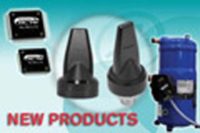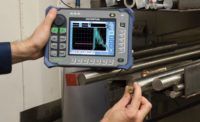If necessity is the mother of invention, then nondestructive testing (NDT) would be among her favorite progeny, at least with the design engineers and manufacturing sect. “It tests the part without destroying it,” said Eric Brown, operations manager at Team Industrial Services, which specializes in NDT.
In an age where parts and systems can range in costs of a few dollars to systems costing millions, testing that keeps the serviceability of the part saves manufacturers time and money.
Nondestructive testing is also commonly referred to as nondestructive examination or evaluation (NDE) and nondestructive inspection (NDI). The American Society for Nondestructive Testing (ASNT) defines it this way: “Nondestructive testing (NDT) is the process of inspecting, testing, or evaluating materials, components or assemblies for discontinuities, or differences in characteristics without destroying the serviceability of the part or system.”
These discontinuities or differences in characteristics can be a variety of things including a small crack in a piece of metal, a seam that is not securely welded, or a ring that does not seal and causes a leak. These discontinuities or flaws have been the cause of some of history’s most devastating losses of human life.
Boilers Explode
In1854 a boiler exploded at Fales & Gray, a railroad car manufacturing company in Hartford, CT. Twenty people died and 50 were seriously injured. The state of Connecticut enacted the Boiler Inspection Law in 1864 requiring an annual visual inspection of boilers. This was the first NDT visual test recorded.
The Connecticut law was of no assistance to the Mississippi steamboat, The Sultan, as it sailed near Memphis, TN. Listed as the greatest maritime tragedy in U.S. history, three of her four boilers exploded killing more than 1,600 people of the 2,500 passengers. It is reported the boilers were repaired in a make-shift manner with metal that was thinner than that on the boiler. This was done to expedite the trip because changing the boilers would have taken at least three days and the repair took only one. Time was of the essence because The Sultan had a legal passenger capacity of about 400 and the boat was filled with more than six times that number.
In 1911 the first boiler code committee was formed and they spent three years developing the first codes. Today there are strict laws, rules and regulation for boilers and pressure vessels for each state and country.
Ultrasonic Flaw Detectors
When thicker metals are used, flaw detection is done with ultrasonic testing. This method was developed by Sergei Y. Sokolov, a Russian scientist dubbed the father of ultrasonic testing. In 1928, he found ways of taking pictures of the actual flaw by using quartz generators that attached to the part or test piece, measured it for optimal energy transference and determined the ultrasonic energy after it transmitted through the part. He used 3,000 megahertz sound waves with a resolution equal to an optical microscope, a piezoelectric receiving transducer, charges generated acoustic signals that continued to be isolated. The mechanical beam scans the transducer face that results in the picture of the flaws. The resolution was not high enough to use for industrial use.
Raimar Pohlman of Germany built upon this by using an ultrasonic imaging method based on transmission using acoustical lenses and conversion of the resulting acoustical image into a visual image. This ultrasonic material testing became popular towards the end of World War II in Germany when choosing ammunition to defend against the air raids of Berlin. Pohlman developed the Pohlman cell, which was a suspension of colloidal aluminum flakes in xylene, sealed in a transparent container. The ultrasonic beam caused the flakes to align in the direction of the beam. If defects were present shadows would appear along the original orientation.
In 1939, scientists at the British Iron and Steel Institute used a testing apparatus like the Pohlman cell to test for hairline factures in steel using ultrasonic waves. This equipment was deemed too sensitive for industry use. In 1942, it is reported Donald Sproule, successfully adapted the principle of echo-sounding to the detection of defects in steel. His apparatus used separate transmitting and receiving transducers.
Floyd Firestone and Adolf Trost were also secretly working on flaw detector testing and its apparatus in different parts of the world without knowledge of the other. Firestone modified a radar instrument and created a transmitter with short pulses and an amplifier with short dead-zone. He was the first to understand the reflection technique.
Trost created the Trost-Tonge. The two probes were contacted on opposite sides of a plate, held by a device called the tonge and coupled to both surfaces by continuously flowing water. Sproule placed the two probes on the same side of the work piece, which resulted in the double-crystal probes. Both Sproule and Firestone found partners and their products were produced commercially in 1952.
Magnetic Particle Testing (MT)
The metals that comprise the boilers and other industrial parts such as pipes, vessels and exchange tanks are tested for cracks and leaks with a Magnetic Particle Test (MT). According to Brown, MT is used for surface or near surface inspections. If the test part is thicker than ½ inch then other methods are used usually Ultrasonic Testing (UT) or X-rays also know as Radiographic Testing (RT). The UT and RT along with the Liquid Penetrant Testing (PT) and the Electromagnetic Testing (ET) are the most popular NDT methods in the industry.
The first use of MT was recorded in 1869 when S. M. Saxby of England tried to detect cracks in gun barrels using magnetic particles. Iron is sprinkled on a magnetic surface, and the iron particles will go in the cracks, making the cracks apparent to visual inspection. Magnetic Particle Testing remains the most commonly used NDT, according to industry professionals. Scientists Dr. Elmer Sperry and H.C. Drake used magnetic induction systems that led to the methods and equipment used for magnetic particle testing.
Electromagnetic Testing
According to industry professionals, Michael Faraday discovered the principles of electromagnetic testing (ET) in 1831 and these principles led to the specific technique of eddy current testing. This process takes a conductive test piece that has been charged with an electromagnetic field of alternating current coils. The flow pattern of the secondary current is the eddy current. If discontinuities are found in the part tested the eddy current will change. These changes can determine the cause of the discontinuities. The first recorded eddy current test was performed by E. E Hughes in 1879 where he found a difference in metals by determining the change in current frequency.
In 1926 the first electromagnetic eddy current instrument was available to measure material thickness. In the late 1930s a team of scientists developed eddy current instruments. In 1948 Friedrich Forster brought eddy testing to industrial use.
Liquid Penetrant Testing
The first liquid penetrant test was known as “Oil and Whiting,” a method used by the railroad industry in 1880 to test for cracks in the rails. The test material was soaked in thinned oil then painted with white coating that dried into a powder. If cracks were present, the oil dripped out and turned the white coating brown, allowing the defects to be detected.
A similar method is used today. A liquid is poured on the surface and fills the cracks. A color contrast developer is used and the penetrant is pulled out of the cracks.
Since its beginning, nondestructive testing has made exponential advancements in quality control and continues to be on the forefront of manufacturing industry technology.




